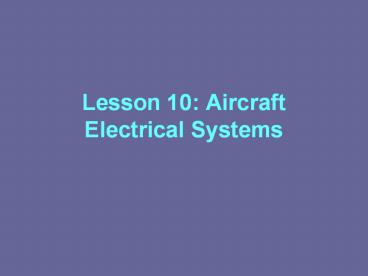Lesson 10: Aircraft Electrical Systems - PowerPoint PPT Presentation
Title:
Lesson 10: Aircraft Electrical Systems
Description:
Impulse coupling Vibrator starting system Shower of Sparks Pulsating DC from the induction vibrator is directed into the magneto coil ... – PowerPoint PPT presentation
Number of Views:107
Avg rating:3.0/5.0
Title: Lesson 10: Aircraft Electrical Systems
1
Lesson 10 Aircraft Electrical Systems
2
Aircraft Electrical Systems
- A circuit must have at least three parts.
3
Aircraft Electrical Systems
- A circuit must have at least three parts.
- The source
4
Aircraft Electrical Systems
- A circuit must have at least three parts.
- The source
- The electron transportation and distribution
system
5
Aircraft Electrical Systems
- A circuit must have at least three parts.
- The source
- The electron transportation and distribution
system - The load (Where the work is done)
6
Series And Parallel Circuits
- Series Circuit
- All electrons must flow through all active
components. - The amount of voltage dropped across the filament
is always less than the total. - Voltage drop depends on the amount of resistance
of the individual load.
7
Series And Parallel Circuits
- Parallel Circuit
- A portion of the electrons flow through each
filament. - The amount of voltage drop is equal to the total
voltage produced by the source.
8
Voltage And Current Measuring Instruments
- Current and voltage are the most commonly
measured variables. - Voltmeters
- Ammeters
9
Voltage And Current Measuring Instruments
- Voltmeters (Parallel)
- Measures current but indicates values of voltage.
- Indicates electrical system condition.
10
Voltage And Current Measuring Instruments
- Ammeters
- Measures current flow
- Battery is charging when electrons are flowing
from the positive terminal. - This would be a positive indication.
11
The Aircraft Electrical System
12
The Aircraft Electrical System
- Source
- 12 volt battery with the negative terminal
connected to the airframe (negative ground). - Master solenoid
- Master switch
13
The Aircraft Electrical System
- The Starter Circuit
- Starter switch circuit (control circuit)
- Starter solenoid circuit (motor circuit)
- The master switch/solenoid circuit must also be
connected.
14
The Aircraft Electrical System
- The Busbar
- Rigid point that is a convenient place to
terminate many wires neatly and safely. - Connected to the positive terminal of the
battery, when the master switch is on. - Same electrical potential as the battery.
- Circuit breakers are often mounted.
15
The Aircraft Electrical System
- The Alternator
- The alternator switch completes a circuit to the
voltage regulator. - The voltage regulator samples the system voltage
and increases or decreases the field voltage
which limits alternator output.
16
The Aircraft Electrical System
- Ammeters And Loadmeter In The Circuit
- Installed between the master solenoid and the
busbar. - Senses the amount and direction of current flow
in the battery circuit. - Installed between A terminal of the alternator
and the busbar. - Senses current flow (in one direction), or
output, of the alternator (loadmeter).
17
Ignition Systems
18
Battery Ignition System
19
Magnetos
- Completely independent of the electrical system
of the airplane. - Primary current is interrupted by a set of
breaker points, and high voltage for the spark
plugs comes from the voltage step-up in the
magneto coil. - Rotating Magnet Magneto
20
Rotating Magnet Magneto
21
Rotating Magnet Magneto
- Resultant Flux (E-gap)
- Maximum current is flowing several degrees after
neutral.
22
Rotating Magnet Magneto
23
Rotating Magnet Magneto
- Dual Magnetos
- High-tension Magnetos
- Low-tension Magnetos
24
High-tension Magneto
25
Low-tension Magneto
26
Rotating Magnet Magneto
- Aids To Starting
- Magnetos provide a good, hot spark at idle, at
cruise, and at high speed. - But not when the engine is turning slowly during
start. - Impulse Coupling
27
Impulse coupling
- A small spring-loaded coupling between the
magneto shaft and the engine drive gear.
28
Impulse coupling
29
Vibrator starting systemShower of Sparks
- Pulsating DC from the induction vibrator is
directed into the magneto coil.































